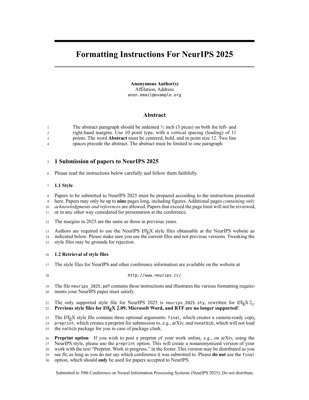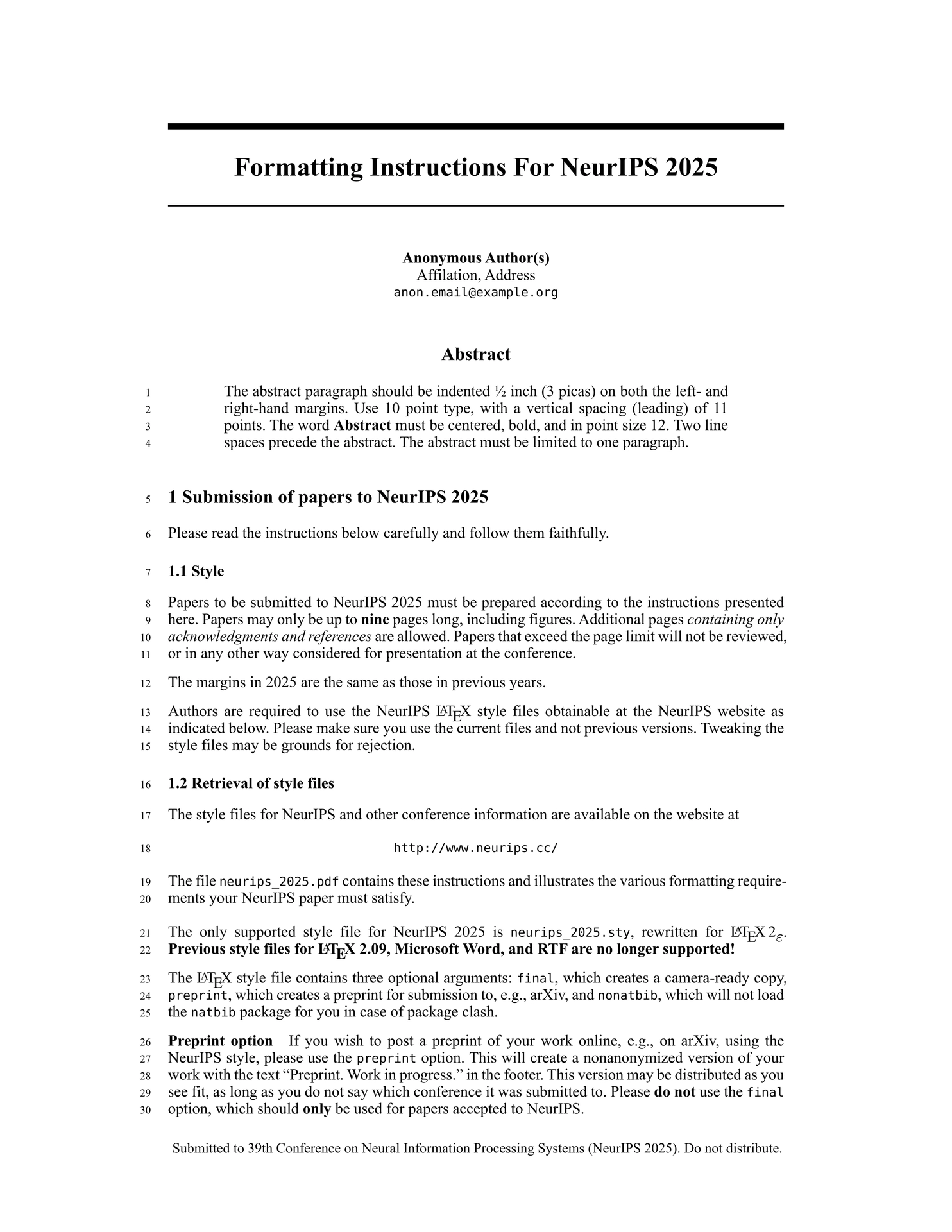Usage
You can use this template in the Typst web app by clicking Start from
template on the dashboard and searching for bloated-neurips.
Alternatively, you can use the CLI to kick this project off using the command
typst init @preview/bloated-neurips
Typst will create a new directory with all the files needed to get you started.
Configuration
This template exports the neurips2023, neurips2024, neurips2025 function
with the following named arguments.
title: The paper’s title as content.authors: An array of author dictionaries. Each of the author dictionaries must have a name key and can have the keys department, organization, location, and email.abstract: The content of a brief summary of the paper or none. Appears at the top under the title.bibliography: The result of a call to the bibliography function or none. The function also accepts a single, positional argument for the body of the paper.appendix: A content which is placed after bibliography.accepted: If this is set tofalsethen anonymized ready for submission document is produced;accepted: trueproduces camera-redy version. If the argument is set tononethen preprint version is produced (can be uploaded to arXiv).
The template will initialize your package with a sample call to the
neurips2025 function in a show rule. If you want to change an existing
project to use this template, you can add a show rule at the top of your file
as follows.
#import "@preview/bloated-neurips:0.7.0": neurips2025
#show: neurips2025.with(
title: [Formatting Instructions For NeurIPS 2025],
authors: (authors, affls),
keywords: ("Machine Learning", "NeurIPS"),
abstract: [
The abstract paragraph should be indented ½ inch (3 picas) on both the
left- and right-hand margins. Use 10 point type, with a vertical spacing
(leading) of 11 points. The word *Abstract* must be centered, bold, and in
point size 12. Two line spaces precede the abstract. The abstract must be
limited to one paragraph.
],
bibliography: bibliography("main.bib"),
appendix: [
#include "appendix.typ"
#include "checklist.typ"
],
accepted: false,
)
#lorem(42)
With template of version v0.5.1 or newer, one can override some parts.
Specifically, get-notice entry of aux directory parameter of show rule
allows to adjust the NeurIPS 2025 template to Science4DL workshop as follows.
#import "@preview/bloated-neurips:0.7.0": neurips
#let get-notice(accepted) = if accepted == none {
return [Preprint. Under review.]
} else if accepted {
return [
Workshop on Scientific Methods for Understanding Deep Learning, NeurIPS
2024.
]
} else {
return [
Submitted to Workshop on Scientific Methods for Understanding Deep
Learning, NeurIPS 2024.
]
}
#let science4dl2024(
title: [], authors: (), keywords: (), date: auto, abstract: none,
bibliography: none, appendix: none, accepted: false, body,
) = {
show: neurips.with(
title: title,
authors: authors,
keywords: keywords,
date: date,
abstract: abstract,
accepted: false,
aux: (get-notice: get-notice),
)
body
}
Issues
-
There is an issue in Typst with spacing between figures and between figure with floating placement. The issue is that there is no way to specify gap between subsequent figures. In order to have behaviour similar to original LaTeX template, one should consider direct spacing adjacemnt with
v(-1em)as follows.#figure( rect(width: 4.25cm, height: 4.25cm, stroke: 0.4pt), caption: [Sample figure caption.#v(-1em)], placement: top, ) #figure( rect(width: 4.25cm, height: 4.25cm, stroke: 0.4pt), caption: [Sample figure caption.], placement: top, ) -
Another issue is related to Typst’s inablity to produce colored annotation. In order to mitigte the issue, we add a script which modifies annotations and make them colored.
../colorize-annotations.py \ example-paper.typst.pdf example-paper-colored.typst.pdfSee README.md for details.
-
NeurIPS 2023/2024/2025 instructions discuss bibliography in vague terms. Namely, there is not specific requirements. Thus we stick to
ieeebibliography style since we found it in several accepted papers and it is similar to that in the example paper. -
It is unclear how to render notice in the bottom of the title page in case of final (
accepted: true) or preprint (accepted: none) submission.

